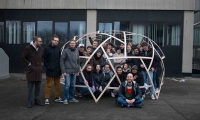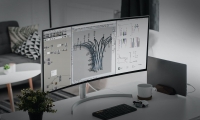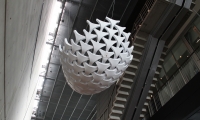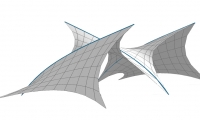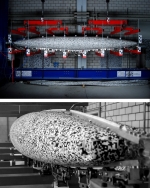Inflatable structures have been used by engineers and architects for several decades. These structures offer lightweight solutions and provide several unique features, such as collapsibility, translucency and a minimal transport and storage volume. In spite of these exceptional properties, one of the major drawbacks of inflatable structures is their limited load bearing capacity. This is overcome by combining the inflatable structure with cables and struts, which results in the structural principle called Tensairity.
A Tensairity structure has most of the properties of a simple air-inflated beam, but can bear to hundred times more load. This makes Tensairity structures very suitable for temporary and mobile applications, where lightweight solutions that can be compacted to a small volume are a requirement. However, the standard Tensairity structure cannot be compacted without being disassembled. By replacing the standard compression and tension element with a mechanism, a deployable Tensairity structure is achieved that needs - besides changing the internal pressure of the airbeam - no additional handlings to compact or erect the structure.
The development of such a deployable Tensairity structure is investigated in this research. Insight is gained in the structural and kinematic behavior of this type of Tensairity structures by means of experimental and numerical investigations on small and large scale models. The first part of this dissertation focuses on the development of an appropriate mechanism for the deployable Tensairity structure. The second part investigates by means of experiments on scale models and numerical investigations the structural behavior of a deployable Tensairity beam and the effect of several design parameters on it. The insight gained in the first two parts results finally in the development of a full scale prototype of a deployable Tensairity beam, which is evaluated experimentally in the third part of this research.
New insights in the structural and kinematic behavior of Tensairity structures are created with this research. They form a solid base for further research on deployable Tensairity structures and bring us one step closer to the realization of an optimal deployable Tensairity beam.
Lars De Laet
Contact
Publications
Links
Lars De Laet
Lars De Laet is Associate Professor at the Department of Architectural Engineering at the Vrije Universiteit Brussel, Belgium, where he was appointed in October 2013 as professor to conduct research in the field of architectural and structural design of resource-efficient structures.
Being educated as an architectural engineer, Lars develops with his team lightweight structures, biological building materials and computer-assisted design methods for sustainable architecture and infrastructure. They develop computational tools for structural design and form-finding, and focus on full-scale prototyping employing new (bio)materials, digital and robotic fabrication technologies and large-scale experimental testing.
Lars is involved in national and European research projects. He was co-chair of the European COST-Action on ‘Novel Structural Skins’ and is a member of various international associations, such as the International Association for Shell and Spatial Structures (IASS) and TensiNet. In addition, Lars has been vice-chair of the board of directors of the VUB, where he is currently a member of the university council. Lars has been elected in 2019 as a member of the Young Academy, part of the Royal Flemish Academy of Belgium for Science and the Arts.
Supervised PhDs
- From Waste to Strength: Assessing the Structural Qualities of Reused Formwork Wood by Gabrielle Nicolas
- Reusable building systems: prototyping lightweight and modular temporary structures by Ellen Leemans
- A hybrid deployable system of integrated scissors grids and surface-active structures by Ahmed Soliman
- Fungal Ties : Mycoremediation for Circular Cities and Resilient Communities by Etienne Issa
- The environmental performances of membrane structures. by Zehra Eryuruk
- Strategies for data-driven low carbon structural design by Sandie Kate Fenton
- Fungi-mediated self-healing concrete: increasing lifespan and durability of concrete structures by inducing self-healing of cracks by Aurélie Van Wylick
- Invisible modularity: A design approach for the facilitated manufacturing of slender shell structures. by Arnaud De Coster
- Fabric formed shell structures utilizing bending active frames and principal stress lines by Lancelot Coar
- Wind-Structure Interactions of Tensile Surface Structures by Jimmy Colliers
- Living Material Fabrication for Sustainable Lightweight Architecture by Elise Elsacker
- Structurally Informed Decision-making by Means of Data Visualisations by Lennert Loos
- Optimal design of gridshells by Jef Rombouts
- Rapidly assembled systems with flexible components: a dialogue between active-bending and transformability by Stijn Brancart
- Biaxial Testing of Fabrics - Test methodologies and their impact on material parameters and the structural design process by Maarten Van Craenenbroeck
- Curved-line folding: a technique to design innovative pliable systems for kinetic architectural applications by Aline Vergauwen
- Lightweight structural concepts for disaster relief sheltering by Jan Roekens
Projects
PhD research
Deployable Tensairity Structures : Development, design and analysis
| Date | 2006 - 2010 |
| Supervisors | Marijke Mollaert and Rolf Luchsinger |
| Funds | Fonds voor Wetenschappelijk Onderzoek - Vlaanderen |
Awards
Lars De Laet received the prestigious Tsuboi Award 2008 from the International Association for Shell and Spatial structures for the "most outstanding paper presented and published in the Proceedings of the previous year's annual IASS Symposium".

